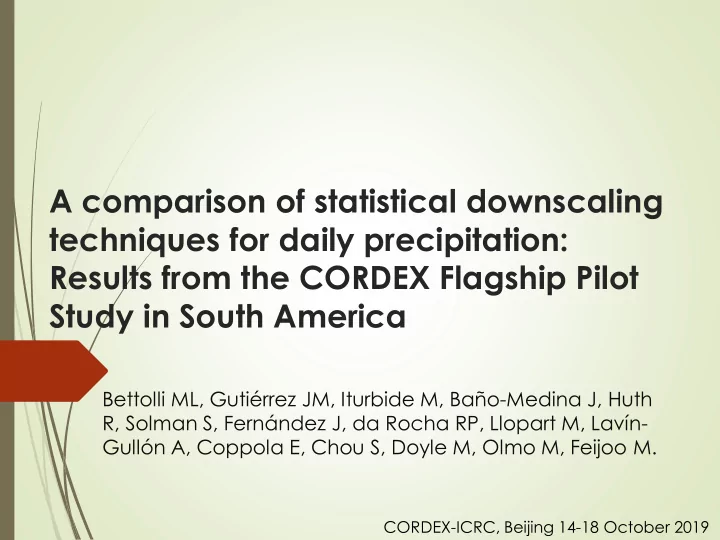

A comparison of statistical downscaling techniques for daily precipitation: Results from the CORDEX Flagship Pilot Study in South America Bettolli ML, Gutiérrez JM, Iturbide M, Baño-Medina J, Huth R, Solman S, Fernández J, da Rocha RP, Llopart M, Lavín- Gullón A, Coppola E, Chou S, Doyle M, Olmo M, Feijoo M. CORDEX-ICRC, Beijing 14-18 October 2019
Objective to intercompare different statistical downscaling techniques in simulating daily precipitation in SESA with special focus on extremes.
Objective to intercompare different statistical downscaling techniques in simulating daily precipitation in SESA with special focus on extremes. To evaluate the sensitivity to the reanalysis choice To evaluate the sensitivity to predictor variables
Strategy and experiment design ESD Simulations 10 Approach: Perfect Prognosis 0 Predictors: ERA-Interim reanalysis -10 JRA reanalysis Predictands : -20 Station Data (100): daily Pr, Tx and Tn MSWEP: daily Pr -30 Season: October to March -40 Training and Test: Cross validation k-folding strategy: -50 6 folds containing 5 consecutive years in the period 1979-2009 Independent Test period: 2009-2010 -80 -70 -60 -50 -40
Strategy and experiment design Method Configuration Predictor Variables GLM_pc PCs (95% variance) Z500, V850, Z1000, Q700, Q850, T700, T850 GLM_pc.C PCs Circulation Variables (95% Z500, V850, Z1000 Generalized variance) linear model GLM_l4 Local predictor values in the four Z500, V850, Z1000, (GLM) nearest grid boxes. Q700, Q850, T700, T850 GLM_ls Combination of local and spatial Local: Q850 predictors (PCs 90%Variance) Spatial: V850, Z500,Z1000 Nearest neighbor, PCs (95% Z500, V850, Z1000, AN_pc variance) Q700, Q850, T700, T850 Analog AN_pc_C Nearest neighbor, PCs Circulation Z500, V850, Z1000 Method Variables (95% variance) (AN) AN_l16 Nearest neighbor, Local predictor Z500, V850, Z1000, values in the four nearest grid boxes. Q700, Q850, T700, T850
Strategy and experiment design Method Configuration Predictor Variables GLM_pc PCs (95% variance) Z500, V850, Z1000, Q700, Q850, T700, T850 GLM_pc.C PCs Circulation Variables (95% Z500, V850, Z1000 Generalized variance) linear model GLM_l4 Local predictor values in the four Z500, V850, Z1000, (GLM) nearest grid boxes. Q700, Q850, T700, T850 GLM_ls Combination of local and spatial Local: Q850 predictors (PCs 90%Variance) Spatial: V850, Z500,Z1000 Nearest neighbor, PCs (95% Z500, V850, Z1000, AN_pc variance) Q700, Q850, T700, T850 Analog AN_pc_C Nearest neighbor, PCs Circulation Z500, V850, Z1000 Method Variables (95% variance) (AN) AN_l16 Nearest neighbor, Local predictor Z500, V850, Z1000, values in the four nearest grid boxes. Q700, Q850, T700, T850
Strategy and experiment design Method Configuration Predictor Variables GLM_pc PCs (95% variance) Z500, V850, Z1000, Q700, Q850, T700, T850 GLM_pc.C PCs Circulation Variables (95% Z500, V850, Z1000 Generalized variance) linear model GLM_l4 Local predictor values in the four Z500, V850, Z1000, (GLM) nearest grid boxes. Q700, Q850, T700, T850 GLM_ls Combination of local and spatial Local: Q850 predictors (PCs 90%Variance) Spatial: V850, Z500,Z1000 Nearest neighbor, PCs (95% Z500, V850, Z1000, AN_pc variance) Q700, Q850, T700, T850 Analog The simulations were performed in AN_pc_C Nearest neighbor, PCs Circulation Z500, V850, Z1000 Method Variables (95% variance) collaboration between the University of (AN) Buenos Aires and the University of AN_l16 Nearest neighbor, Local predictor Z500, V850, Z1000, Cantabria ( Climate4R ) values in the four nearest grid boxes. Q700, Q850, T700, T850
Results Differences DJF JJA BIAS K-S Between BIAS K-S JRA and ERA-I
Results ERA-I Warm Season JRA 2009/10 1979-2009 Wet Day Intensity Ratio downscaled/OBS
Results Raw data: Underestimate GLM: overestimate AN: OK ERA-I Warm Season 2009/10: considerable spread JRA 2009/10 1979-2009 Wet Day Intensity Ratio downscaled/OBS
mm/day Results Wet Day Intensity 1979-2009 Even tough the GLM tended to overestimated the values, they are able to reproduce the spatial behavior of the wet day intensity.
Results ERA-I Warm Season JRA 2009/10 1979-2009 Wet Day Frequency Ratio downscaled/OBS
Results Raw data: Overestimation GLM: OK AN: Spatial spread in performances ERA-I Warm Season 2009/10: considerable spread JRA 2009/10 1979-2009 Wet Day Frequency Ratio downscaled/OBS
Results Raw data: Overestimation GLM: OK AN: Spatial spread in performances ERA-I Warm Season 2009/10: considerable spread JRA 2009/10 Except for the AN that considers the full set of predictor variables 1979-2009 Wet Day Frequency Ratio downscaled/OBS
GLM: performs best Results ERA-I Warm Season JRA 2009/10 Daily Temporal Correlation
GLM: performs best Results 2009/10: some differences depending on the reanalysis choice and the predictor set are evident . ERA-I Warm Season JRA 2009/10 Daily Temporal Correlation
All methods show similar Results performances but GLM: present more spread ERA-I Warm Season JRA 2009/10 1979-2009 R20 Ratio downscaled/OBS
R20 (Ratio) Results ERA-I Warm Season JRA 2009/10 1979-2009 R20 Wet Day Intensity Ratio downscaled/OBS
Raw data and GLM: underestimate Results the P98 AN: perform best ERA-I Warm Season JRA 2009/10 1979-2009 P98 Relative Bias
Concluding remarks The results show that the methods are generally more skillful when combined predictors including temperature and humidity at low levels of the atmosphere are considered. The performance of the models is also sensitive to reanalysis choice. The methods show overall good performance in simulating daily precipitation characteristics over the region, but no single model performs best over all validation metrics and aspects evaluated.
Thanks!
Recommend
More recommend